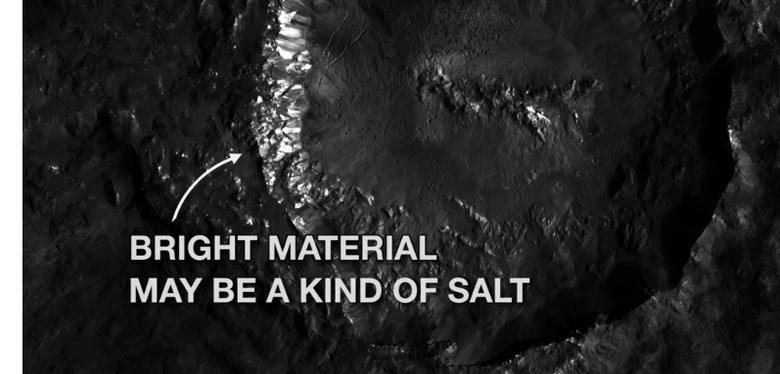NASA Ceres Low-Orbit Pics Show Salt, Mountains, Shiny Craters
Yesterday, NASA researchers unveiled a bunch of images revealing a close-up look at Ceres, the dwarf planet. These images were captured by the Dawn spacecraft when it was at its lowest orbit, and they include some detailed views of the Occator Crater, as well as the shiny surfaces causing those mysterious bright spots. A color-enhanced map of Ceres has been released, as well as a video explaining different features on the landscape.
NASA scientists presented the images at the 47th annual Lunar and Planetary Science Conference in Texas on Tuesday. Said Dawn co-investigator Ralf Jaumann, "Before Dawn began its intensive observations of Ceres last year, Occator Crater looked to be one large bright area. Now, with the latest close views, we can see complex features that provide new mysteries to investigate."
He went on to describe the crater's interior as having an 'intricate geometry,' and said it points toward recent (relatively speaking) geological activity in Ceres' history. Precisely how it was formed hasn't been worked out, but researchers continue to search.

The Occator Crater — shown in the video below — is 57 miles across and about 2.5 miles deep, and it is exceptionally shiny, so much so that it reflected light brightly enough to tease the Dawn spacecraft and all of humanity watching it. The crater has a bright center and smooth walls likely made of salt.
Looking beyond just the crater, the NASA team created an enhanced color map of the planet's surface, doing so to highlight specific aspects of it that aren't readily discernible in black-and-white. Researchers were surprised to learn there are less big impact basins than had been anticipated, though the smaller array of basins was in line with expectations. When looking at the map, the blue portions are areas with mountains, smooth plains, and flows.
The landscape is largely described as 'diverse,' though, with NASA pointing toward the Haulani Crater as one example of that diversity. The crater is shaped irregularly and contains "striking bright streaks of material," says the space agency. The surface materials are presented in differing proportions versus the surrounding surface, though it all is made mostly of phyllosilicates and carbonates.
More exciting is the Oxo Crater, where the spacecraft's VIR instrument detected water. The crater is described as young and relatively small at 6-miles across. The detected water could be in the form of ice or could be locked up in minerals, and could have been exposed when the impact happened. This marks the only part of the dwarf planet where Dawn has come across water.
SOURCE: NASA
